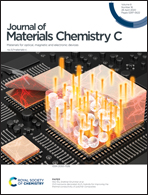Effect of polymer donor aggregation on the active layer morphology of amorphous polymer acceptor-based all-polymer solar cells†
Abstract
Most of the polymer acceptors for all-polymer solar cells (all-PSCs) are semi-crystalline. Amorphous polymer acceptors containing B ← N units represent a new class of acceptor materials and possess unique phase separation behaviours in all-PSCs. In this work, to study their phase separation morphology and all-PSC device performance, we select three polymer donors with an identical polymer backbone but different side chains to blend with an amorphous polymer acceptor (rr-PBN). Among the three polymer donors, J91 exhibits the strongest aggregation tendency in solution and moderate crystallinity in thin film. The J91:rr-PBN blend shows the most optimal phase separation morphology and the best all-PSC device performance. In comparison, J51 shows the least aggregation tendency in solution and the highest crystallinity in thin film. The all-PSC device of the J51:rr-PBN blend exhibits sub-optimal active layer morphology and poor photovoltaic performance. These results indicate that the aggregation tendency in solution of polymer donors is the dominant factor in the phase separation of semi-crystalline polymer donor/amorphous polymer acceptor blends in all-PSCs.



 Please wait while we load your content...
Please wait while we load your content...